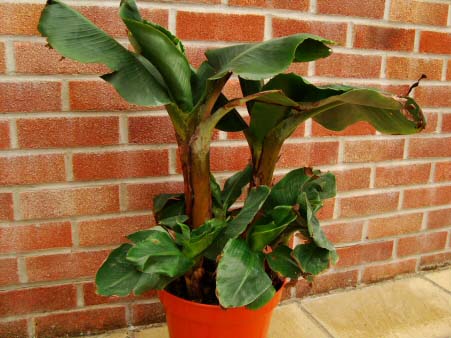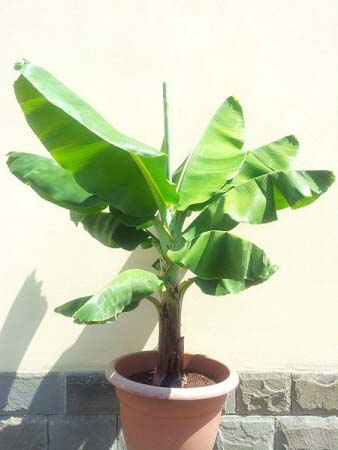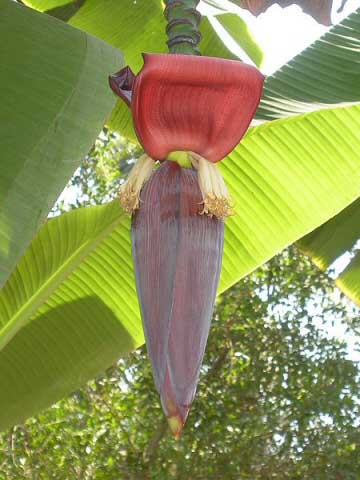





Musa or the Banana is one of the most well known fruits in the world, as well as being delicious and nutritious some varieties can be grown easily and effectively as house plants. Often Dwarf Banana plants are found growing in parts of Asia for mass cultivation and they are sometimes grown as tall specimen plants in gardens at the back of borders to add a touch of the tropics.  However as they need significant Winter protection it's relatively uncommon for them to be grown like this by the average gardener.
However as they need significant Winter protection it's relatively uncommon for them to be grown like this by the average gardener.
It might therefore seem an unlikely house plant but actually its been grown indoors since the Victorian times, where they were proudly displayed in their warm light conservatories. Of course the Victorian conservatories were a little different (and significantly bigger) than the ones we have today, however the basic principle is similar. Although you might call it a conservatory, sunroom, solarium, or garden room it is essentially the same but on a smaller scale to the Victorian constructions. If you own a Dwarf Cavendish or have a curiously about buying one then you will already know they are a delight, especially if you treat them right.
Although true Banana plants are far too large for any house, the Dwarf Musa Banana, or Dwarf Cavendish, fits right in. They can of course be grown in other rooms of the house, but a conservatory is an ideal situation, often giving humid, bright and spacious living accommodation which this plant craves and ultimately needs in order to do well.
These "Dwarfs" can still easily reach 6ft / 2m, so with this in mind a young new plant will live happily on a window ledge for a few years at most but that's it, afterwards the space will have run out and you will need somewhere bigger.  They are somewhat fussy when it comes to care and the leaves although massive and quick growing are incredibly weak and susceptible to damage. Feeding, copious watering and large containers are necessary and don't even think about keeping them in a cold room over Winter or your Banana Plant will be a mushy mess by Spring.
They are somewhat fussy when it comes to care and the leaves although massive and quick growing are incredibly weak and susceptible to damage. Feeding, copious watering and large containers are necessary and don't even think about keeping them in a cold room over Winter or your Banana Plant will be a mushy mess by Spring.
They grow quickly when it's warm, rewarding you with one new leaf every week or so, they look truly stunning and unique all the time, adding a tropical interest to any area. If allowed to reach its statuesque proportions, it will dominate in a graceful balanced way that very few house plants can ever match. Will you get Banana fruit to eat? It's a possibility, but conditions will have to be exceptional so best not to hold your breath.
When buying a Banana plant for use as a house plant you want to look for the common Musa × paradisiaca 'Dwarf Cavendish', in fact it will probably be the only one you will be able to find anyway. It will give you the large size aspect, quick growth along with the potential of edible fruit. It will also tolerate being kept indoors all year round.
M. basjoo is great for the garden because it's the most hardy, however its banana's are inedible and the truck becomes fibrous over time which doesn't lend itself well to indoor decor. M. acuminata 'Dwarf Cavendish' is similar to M. basjoo as it lends itself well as a garden plant In temperate regions, it's size is more compact but again no familiar fruit will be produced in the short term and it doesn't do particularly well if kept indoors all year long.
Light
The Common Banana must have good light, but will actually accept a range of light conditions from part shade to full sun. Young plants and new leaves may scorch in full Summer sun especially if your watering routine is stingy.
Watering
A well established Banana plant will need copious watering during the warmest months of the year and a good deal more than most house plants during Spring and Autumn / Fall. This is down to its large leaf surface area which allows a lot of transpiration to take place - a good thing in the dry atmosphere of a centrally heated home.
Water when the top 4cm / 2 inches of compost is dry. In a very bright, warm spot you could be doing this as much as every other day in Summer. Significantly cut back in Winter though otherwise you will be inviting rot to take over.
An established plant will need copious watering during the warmest months
Humidity
The leaves might look tough but are actually very delicate and will rip easily if certain conditions are poor. Low humidity is often a contributing factor to leaf damage so moisture retentive pellets in the drip tray would be helpful, along with a regular misting.
Feeding
This plant has large leaves which form very rapidly during the growing season, so much so a brand new leaf every 10 days isn't uncommon, therefore feeding on a frequent basis is a must.
Feed well every 2 or 3 weeks using either a general liquid garden fertiliser such as Miracle Grow or if you make your own, that should be fine to use also. You can of course use a feed designed for house plants too. Do not fertilise when the plant isn't growing or if you don't want to support any new growth, for example if it's already overgrown and further height is undesired.
Temperature
There isn't really a upper temperature limit found in the home that is damaging Although heat pockets, or sun traps such as inbetween windows and curtains should be avoided as they often heat up too rapidly for the plant to adapt.
When it comes to the lowest acceptable temperature this will depend on the variety you are growing. Some Banana's will survive down to freezing, but in our experience of growing the Dwarf Cavendish, it will start to take damage if you put in in an area lower than 10°C / 50°F. (One year the entire plant above the soil was lost, luckily the rhizome lived on and regrew the following Spring, still, it wasn't ideal as it had to regrow everything it had lost!).
Repotting
Young plants, also known as "pups", will fill small pots quickly so you need to repot them into bigger ones quite frequently, this may be as much as two or three times in the first year. Normal potting compost at this stage is all you need.
Young plants are known as "pups"
As they get older you can reduce the repotting to once a year. As Banana's are gross feeders it makes sense to enrich the new soil too, so you're welcome to use home made compost or even horse manure like you would for many garden plants. However if you use home made compost or animal manure it must be well rotted. You will risk serious damage to the roots and rhizome if you don't use fully decomposed material. Finished compost is dark brown or black with a crumbly-textured that has a rich earthy smell, if you aren't sure, play it safe and stick to normal potting soil.
Propagation
The Dwarf Cavendish has a suckering tendency, so young "pups" will be produced as the parent ages. They can be carefully cut away from the main plant, trying to keep some of the roots attached, and then potted up immediately. More details can be found on our offsets section in the propagation article.
Speed of Growth
Fast growing, as much as one new leaf every week or so during the growing season.
Height / Spread
The variety you have and the growing environment you provide will determine the eventual height. Keeping the plant in a container that is too small, not feeding or generally being "cruel" will mean the maximum height will never be achieved (which might be your intention if space is sparse).  Realistically an indoor Banana won't ever exceed 3m / 10ft in height, in fact, half this size would still be considered generous.
Realistically an indoor Banana won't ever exceed 3m / 10ft in height, in fact, half this size would still be considered generous.
Flowers
There are flowers and as you might expect they precede the rare banana fruit. Quite beautiful and unusual in appearance, but at the end of the day they are uncommon indoors. This is because the plants needs good light and a warm home for a long continuous period, unless you are based in a country near the equator you will get four distinctive seasons every year, one of which is always cold and this can scupper the long continuous period of heat unless you can provide artificial heat.
If growing your own bananas is your aim outside of a warm zone you must provide artificial heat and lighting in Winter. Should you be fortunate enough to "grow your own" the fruits will need around 3 months to ripen, so leave them on the plant until then.
Anything else?
The leaves are delicate so if you wash them be careful and avoid leafshine products. All bananas will enjoy being outside in the warmest months of the year, so if you can Summer them outdoors in a sheltered corner they will thank you for it.
Copyright © www.100flowers.win Botanic Garden All Rights Reserved